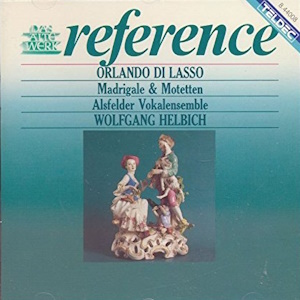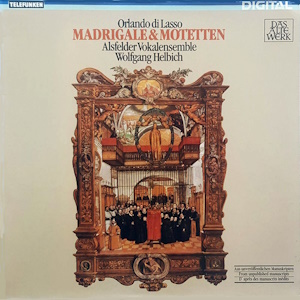 |
| 1 CD -
8.44008 ZS - (C) 1988 |
 |
| 1 LP -
6.42632 AZ - (p) 1981 |
|
MADRIGALE & MOTETTEN
|
|
|
|
|
|
|
|
|
|
| Orlando di LASSO
(um 1532.1594) |
VIER
ITALIENISCHE MADRIGALE |
|
|
|
|
|
- Al dolce suon'
- fünfstimmig (komponiert 1568/69) |
|
2' 56" |
1 |
A1
|
|
- Ben convenne ·
II. parte: Solo n'andrò -
fünfstimmig (komponiert 1568/69) |
|
4' 28" |
2 |
A2
|
|
- Ove d'altra
montagna - vierstimmig
(komponiert um 1566/67) |
|
3' 23" |
3 |
A3
|
|
-
Spent' è d'amor · II. parte: Ma
che morta - fünfstimmig
(komponiert 1568/69) |
|
4' 21" |
4 |
A4
|
|
ZWEI
LATEINISCH-FRANZÖSISCHE CHANSONS
|
|
|
|
|
|
- Lucescit jam o
socii · II. parte: Nunc bibamus
non segniter - vierstimmig
(komponiert um 1580) |
|
2' 48" |
5 |
A5
|
|
- Voir est
beaucoup - vierstimmig
(komponiert um 1558) |
|
1' 36" |
6 |
A6
|
|
VIER
MOTETTEN
|
|
|
|
|
|
- Domine, quando
veneris - fünfstimmig
(komponiert 1566/67) |
|
3' 49" |
7 |
B1
|
|
-
I. pars: Beati pauperes · |
|
4' 18" |
8 |
B2 |
|
-
II. parte: Beati pacifici -
vierstimmig (komponiert um 1571) |
|
2' 55" |
9 |
B3 |
|
-
Da pacem Domine - fünfstimmig
(komponiert um 1585) |
|
2' 21" |
10 |
B4 |
|
-
Gloria patri et filio, et
spiritui sancto - sechsstimmig
(komponiert 1565) |
|
1' 26" |
11 |
B5 |
|
ZWEI
LATEINISCHE MADRIGALE
|
|
|
|
|
|
-
Praesidium Sara - vierstimmig
(komponiert um 1568) |
|
3' 38" |
12 |
B6 |
|
-
Bestia curvafia pulices -
fünfstimmig (komponiert 1573-1575) |
|
0' 58" |
13 |
B7 |
|
|
|
|
|
| ALSFELDER
VOKALENSEMBLE |
|
| Wolfgang Helbich,
Leitung |
|
|
|
|
|
Luogo
e data di registrazione |
|
- |
|
|
Registrazione:
live / studio |
|
studio |
|
|
Producer /
Engineer |
|
- |
|
|
Prima Edizione
LP |
|
Telefunken
- 6.42632 AZ - (1 LP) - LC 0366 -
durata 40' 17" - (p) 1981 -
Digital |
|
|
Edizione
"Reference" CD
|
|
Tedec
- 8.44008 ZS - (1 CD) - LC 3706 -
durata 40' 17" - (c) 1988 - DDD |
|
|
Cover |
|
"Musizierendes
Kinderppar", Porzellan. Modell von
J. J. Kaendler, Meißen um 1765.
Museum für Kunst und Gewerbe,
Hamburg.
|
|
|
|
|
Orlando
di Lasso (Lassus):
Latin Motets, French
Chansons, Italian
Madrigals from
rediscovered prints
1559-1588
The present collection
contains compositions by
Palestrina's greatest
contemporary. after a
varied youth in France,
Italy and his native
South Netherlands (now
Belgium), Lassus spent
close on 40 years in
Munich at the court of
Dukes Albrecht V and
William V of Bavaria,
where he rose to the
position of director of
court music and acquired
world-wide fame. No
other composer before or
since has received such
acclaim or was so widely
published during his
lifetime. And yet some
of his finest works have
until quite recently
been either lost or only
incompletely preserved.
Since at that time no
full scores existed
apart from the so-called
Choir Books, but only
separate part books,
many settings were
available only in an
isolated part, e. g.
alto or bass, from
which, as many earlier
researchers discovered
to their deep regret,
reconstruction was
impossible.
The author of this
introduction originally
reported on missing
parts which he had found
in foreign libraries
(vide Die
Musikforschung, 1955,
"Neue Lasso-Funde" -
"New Lassus
Discoveries"); he then
produced complete scores
of the realised settings
(Orlando di Lasso,
complete edition, new
series commissioned by
the Académie Royale de
Belgique and the
Bavarian Academy of
Sciences, Vol. I, 1956).
Since then he has been
able to unearth
additional part books
from their hiding
places, giving a
detailed account of
their discovery in the
Archiv für
Musikwissenschaft 1965.
These publications and
his monograph on Lassus
(Kassel-Basel 1959,
Bibliography, pp. 77
ff.), which fills in a
few gaps, provide a
musical repertoire; this
record will give lovers
of renaissance music a
delightful sample which
in many respects afford
new insights into the
works of this "princeps
musicorum", as his
contemporaries called
him.
The
following works have not
yet appeared in print:
the reconstructed
madrigal “Spent' è
d’amor”, “Ma che morta’,
“Ove d’altra montagna”,
“Ben convenne”, “Solo
n’andro” and “Al dolce
suon”. They are put
together from sparse
fragments of part books
dating from 1567 and
1569; in this process
several editions were
used to supplement one
another. They provide
magnificent madrigalian
images of ecstatic
poetry, taken partly
from Petrarch’s
“Canzoniere” and partly
from texts by the
humanist Minturno, one
of the reformers of the
Canzone; they have given rise
to fascinating, detailed
musical word-painting,
the “imitazione delle
parole”, something quite
new in Lassus’ middle
period in which,
incidentally, he also
set poems by the
diplomat Manrique (the
charming “Al dolce
suon”). Side by side
with this idealistic
poetry we find “Bestia
curvafia pulices”, a
coarse Latin “Song of
the flea”: a mockinge
piece of a type which at
that time found
questionable favour. All
the words start with the
letter p and curse the
“lazy, crooked vermin”
in the manner of student
tomfoolery. “Praesidium,
Sara”, on the other
hand, is grave; itis
probably a wedding song,
evoking “the winged gods
of love within the
breast”. “Gloria patri”
and “Da pacem” are parts
of the Catholic mass and
similarly belong to the
middle period of the
“mature” Lassus, in
which he used broad
vocal lines and mighty
sonorities. “Beati
pauperes” with the
second part is a moving
setting of the
Beatitudes, in which the
peacemakers are promised
great rewards in heaven.
It is possible that the
Catholic Lassus wrote it
for the French
Huguenots, who were
experiencing great
trials and tribulations,
shortly before they were
so cruelly massacred on
St. Bartholomew’s Day.
“Domine, quando veneris”
is another solemn piece.
In this new milieu, a
drinking song “Lucescit
jam o socii” with French
and Latin words,
containing frivolous
phrases such as “Nunc
bibamus non segniter -
let us now drink not
unindustriously” and
strangely distorted
bible texts, strikes one
as very peculiar. No
less interesting from
the point of view of the
history of civilisation
is the French chanson
“Voir est beaucoup”,
starting with a solemn
exhortation “To see is
much, to keep quiet
about it even more” and
then pouring out its
music in bold sweeps.
In this way, this
recording provides
across section of widely
differing types of
setting, ranging from
the profound devotion of
a saintly community to
the ironic middle-class
Gesellschaftslied of a
dying polyphony at the
end of the renaissance.
(In addition to the
motets, chansons and
madrigals that can be
heard on this record for
the first time in more
than 400 years, those
interested in the genre
can discover, in the
editor’s works already
listed, information
about the other settings
which have been rescued
from fragmentary part
books and constitute a
revival of a
timehonoured art from.
Wolfgang
Boetticher
(Translation:
Lindsay Craig)
|
|